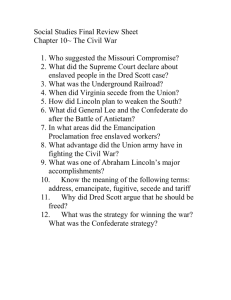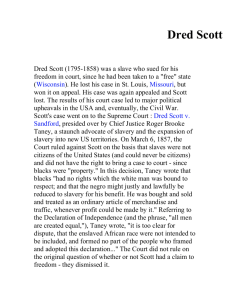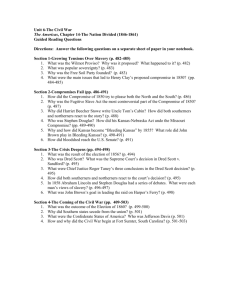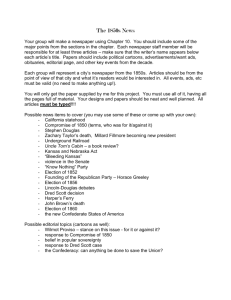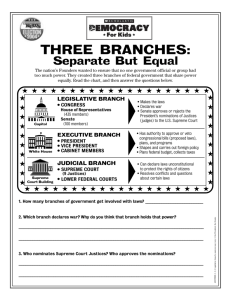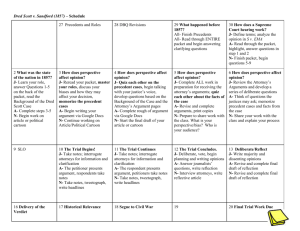Dred Scott v. Sandford Student Handout
advertisement
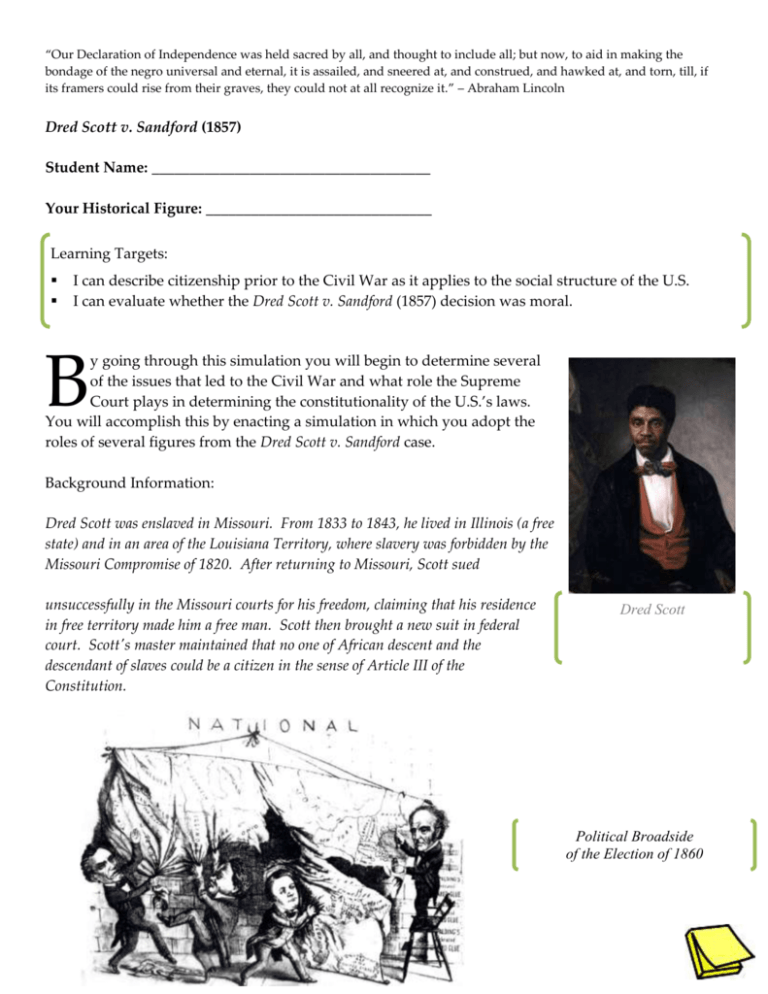
“Our Declaration of Independence was held sacred by all, and thought to include all; but now, to aid in making the bondage of the negro universal and eternal, it is assailed, and sneered at, and construed, and hawked at, and torn, till, if its framers could rise from their graves, they could not at all recognize it.” – Abraham Lincoln Dred Scott v. Sandford (1857) Student Name: _____________________________________ Your Historical Figure: ______________________________ Learning Targets: I can describe citizenship prior to the Civil War as it applies to the social structure of the U.S. I can evaluate whether the Dred Scott v. Sandford (1857) decision was moral. B y going through this simulation you will begin to determine several of the issues that led to the Civil War and what role the Supreme Court plays in determining the constitutionality of the U.S.’s laws. You will accomplish this by enacting a simulation in which you adopt the roles of several figures from the Dred Scott v. Sandford case. Background Information: Dred Scott was enslaved in Missouri. From 1833 to 1843, he lived in Illinois (a free state) and in an area of the Louisiana Territory, where slavery was forbidden by the Missouri Compromise of 1820. After returning to Missouri, Scott sued unsuccessfully in the Missouri courts for his freedom, claiming that his residence in free territory made him a free man. Scott then brought a new suit in federal court. Scott's master maintained that no one of African descent and the descendant of slaves could be a citizen in the sense of Article III of the Constitution. Dred Scott Political Broadside of the Election of 1860 I t is important to remember that this is a simulation of oral arguments in the Supreme Court and not a trial. No evidence is collected and no witnesses are called. The lawyers for both sides are simply putting forth their best legal arguments, and answering the questions that the justices have. Roles: Below are the roles and a brief description of who these people are. There will be the lawyers for Dred Scott and lawyers for John F.A. Sanford. These will also be nine Supreme Court Justices. The rest of the people will be either newspaper reporters or magazine editors from the following Civil War era papers. Chief Justice, Roger B. Taney Dred Scott (Petitioner) – man attempting to sue for his freedom* John F.A. Sanford (Respondent) – Brother-in-law and current owner of Dred Scott (Dr. John Emerson was the original owner and now is deceased)* Lawyers for Dred Scott Lawyers for John F.A. Sanford Roger B. Taney – Chief Justice of the Supreme Court Benjamin R. Curtis – Supreme Court Justice James M. Wayne – Supreme Court Justice John A. Campbell – Supreme Court Justice John Catron – Supreme Court Justice John McLean – Supreme Court Justice Peter V. Daniel – Supreme Court Justice Robert C. Grier – Supreme Court Justice Samuel Nelson – Supreme Court Justice Newspaper Reporter from the New York Tribune Newspaper Reporter – the New York Sun Newspaper Reporter – the Liberator Magazine Writer – Harper’s Weekly Newspaper Reporter – Virginia Enquirer Newspaper Reporter – Charleston Mercury Newspaper Reporter – Mississippi Daily Courier Newspaper Reporter – North Carolina Standard Newspaper Reporter – Georgia Federal Union *Dred Scott and John F.A. Sanford will not be at the trial; they are represented at the trial by their lawyers. 2 Dred Scott v. Sandford (1857) – Precedent Cases & Etc. Actively read the precedent cases and create a one-sentence summary. Rachel v. Walker (1836 Missouri Supreme Court case) Missouri's case law prior to the Dred Scott case showed that in the cases where slave owners took slaves to free territory and then returned to the slave state, the slaves were actually emancipated (freed) upon arrival in the free state. This was based on an informal legal precedent called "comity" (one court recognizing the jurisdiction or authority of another.) This particular case determined that even a slave-holing officer residing on a military post in a free state was obligated to follow that state's rules. (Fehrenbacher, 130) 1. One-sentence Summary: U.S. v. The Amistad (1841 U.S. Supreme Court case) In this case, kidnapped Africans were transported from Guinea to Cuba on a Portuguese slave ship in violation of Spanish laws forbidding the international slave trade. The slaves were sold to two Spaniards who were overpowered by the Africans while transporting them on the Amistad. The Africans were attempting to return to Africa, but the ship landed near Long Island, New York and they were taken to New London, Connecticut. La Amistad The Supreme Court ruled in favor of the Africans stating that there was no evidence that the Africans were in fact slaves (they found that the documents that the Cubans had given were falsified.) However, even though the Court did rule in the Africans favor, they did not use the language of the defense argument which stated that because the Africans were brought into the free states of New York and Connecticut they were legally free. (Wiecek, 41-43) 2. One-sentence Summary: 3 Prigg v. Pennsylvania (1842 U.S. Supreme Court case) This case dealt with the constitutionality of personal liberty laws in free states. In this case Pennsylvania's 1826 law was used to prosecute a slave-catcher (Prigg) who had taken Margaret Moran to Maryland without the required "certificate of removal." The Supreme Court held that the Pennsylvania act was unconstitutional and that a master had the right to recapture runaway slaves based on common law or because of the fugitive-slave clause in the Constitution. 3. One-sentence Summary: Handbill encouraging people to catch slaves and return them to their owners. Strader v. Graham (1851 U.S. Supreme Court case) In this case two slave musicians were taken into Ohio and then later escaped from Kentucky to Canada. The slave-owner captured them back and it was argued in court that they were freed the minute they set foot on free soil. The Kentucky Court of Appeals decided in favor of the slave-owner (it was really a suit for damages by the slave-owner against the men who had aided the slaves in their escape.) The Supreme Court dismissed the case stating it lacked jurisdiction (authority) because the Northwest Ordinance did not apply to Ohio because it was superseded by state law, thus the case did not present a federal question. Taney's opinion in this case outlined the idea that once the slaves were returned to Kentucky, Kentucky law applied and Ohio law could not be considered. 4. One-sentence Summary: 4 Naturalization Act of 1802 Be it enacted by the Senate and House of Representatives of the United States of America in Congress assembled That any alien being a free white person may be admitted to become a citizen of the United States or any of them on the following conditions and not otherwise First That he shall have declared on oath or affirmation before the supreme superior district or circuit court of some one of the states or of the territorial districts of the United States . . . three years at least before his admission that it was . . . his intention to become a citizen of the United States and to renounce for ever [sic] all allegiance and fidelity to any foreign prince potentate state or sovereignty. . . . Secondly That he shall at the time of his application to be admitted declare on oath or affirmation before some one of the courts aforesaid that he will support the constitution of the United States and that he doth absolutely and entirely renounce and abjure all allegiance and fidelity to every foreign prince potentate state or sovereignty. . . . Thirdly That the court admitting such alien shall be satisfied that he has resided within the United States five years at least and within the state or territory where such court is at the time held one year at least and it shall further appear to their satisfaction that during that time he has behaved as a man of a good moral character attached to the principles of the constitution of the United States. . . . SEC 4 And be it further enacted That the children of persons duly naturalized under any of the laws of the United States or who previous to the passing of any law on that subject by the government of the United States may have become citizens of any one of the said states under the laws thereof being under the age of twenty one years at the time of their parents being so naturalized or admitted to the rights of citizenship shall if dwelling in the United States be considered as citizens of the United States and the children of persons who now are or have been citizens of the United States shall though born out of the limits and jurisdiction of the United States be considered as citizens of the United States provided That the right of citizenship shall not descend to persons whose fathers have never resided within the United States 5. One-sentence Summary: 5 Missouri Compromise 6. One-sentence Summary: 6 Compromise of 1850 Popular Sovereignty – People could vote to determine whether or not they wanted slavery 7. One-sentence Summary 7 Notes on Dred Scott v. Sandford (1857) In each box, jot down evidence presented by that person regarding whether you think Dred Scott should be a citizen of the U.S. and ultimately, a free man. Include in your notes any information about the background of the speaker (where he is from, the types of questions being asked, and how strong of a case they are making). *One newspaper editor may live tweet this event in lieu of taking notes. Lawyers: Issue: Whether Dred Scott is a citizen of the U.S. and a free man? Lawyers for the Petitioner: (Dred Scott) Lawyers for the Respondent: (John F.A. Sanford) 8 Supreme Court Justices: Issue: Whether Dred Scott is a citizen of the U.S. and a free man? Roger B. Taney, Chief Justice Benjamin R. Curtis, Justice James M. Wayne, Justice John A. Campbell, Justice 9 Peter V. Daniel, Justice John Catron, Justice John McLean, Justice Robert C. Grier, Justice Samuel Nelson, Justice 10 Newspaper Headlines during Trial: Dred Scott v. Sandford (1857) In the box below write down the headline from each newspaper at the end of each court day. Newspaper: New York Tribune Headlines: Day I: Day II: Day III: Day I: The New York Sun Day II: Day III: Day I: The Liberator Day II: Day III: Day I: Harper’s Weekly Day II: Day III: Day I: Virginia Enquirer Day II: Day III: Day I: Charleston Mercury Day II: Day III: Day I: Mississippi Daily Courier North Carolina Standard Georgia Federal Union Day II: Day III: Day I: Day II: Day III: Day I: Day II: Day III: 11 Reflection Post-Trial: Dred Scott v. Sandford (1857) Before Justices’ Decision Answer the following questions in a paragraph response: Who do you think won and why? What were the strengths and weaknesses of both sides? 12 Post-Justices’ Decision Were you surprised by the decision and why? Who argued the case better; what was missed? Was it a moral decision? Explain your choice. 13 Dred Scott Rubric: Task Worth What to Do for Full Credit 35 Attorneys: Actively read through your material and complete the corresponding questions (history, precedents, etc.) – 10 Craft a 2-4 page essay addressing your case by covering the following: the facts, issue, precedents, you argument, and the conclusion the day before the trial – 15 Compile a list of questions that the justices might ask - 10 Justices: Actively read through your material and complete the corresponding questions (history, beliefs, etc.) – 10 Annotate Schwarzenegger v. Entertainment Merchants Association (2010) notes and answer the questions that follow – 10 Actively read through the attorneys’ essays and come up with questions to quiz them based on your interpretation of the law – 15 Newspaper Editors: Actively read through your material and complete the corresponding questions (history, precedents, etc.) – 10 Create a political cartoon (with a paragraph explaining your rationale) or an article addressing the climate of the country prior to the case (How do entice the readers of your paper?) – 25 20 Attorneys: Reading through opening statement, facts, issues, precedents, closure – 5 Taking notes on the trial in the student handout (judges questions, opposition, etc.) – 10 Addressing questions from judges – 5 Justices: Taking notes on the trial in the student handout (judges questions, attorneys, etc.) – 10 Interrupting with questions (using the techniques learned from the Supreme Court audio) – 10 Newspaper Editors: Taking notes on the trial in the student handout (judges questions, attorneys, etc.)/One editor will live Tweet the entire trial – 10 Creating and presenting a one-sentence summary or headline of the case for the day for your newspaper – 10 Post-Trial 20 Attorneys & Newspaper Editors: Complete reflection before justices deliver their opinion which addresses the following: – 20 o Who do you think won and why? o What were the strengths and weaknesses of both sides? After justices deliver their opinions, complete the second part of the reflection: o Were you surprised by the decision and why? o Who argued the case better; what was missed? o Was it a moral decision? Justices: Secretly vote and write a majority decision together via Google Docs; two others will craft the dissent – 20 Read the majority decision; read the dissent Justices will voice their individual opinions when it comes to the rulings Total 75 Planning Trial Comments /75 14 Name: _________________________ Period ____ Rank the roles in order from your top choice, to your least desirable choice. 1. ___________________________________________________________________ 2. ___________________________________________________________________ 3. ___________________________________________________________________ Complete the chart with your group to address what each group’s role is at the different stages. Stages Attorneys Justices Newspaper Editors Pre-trial During Trial Post-trial 15
